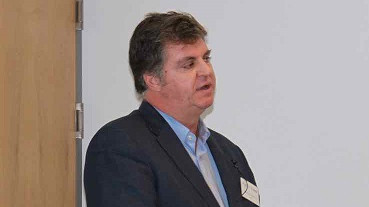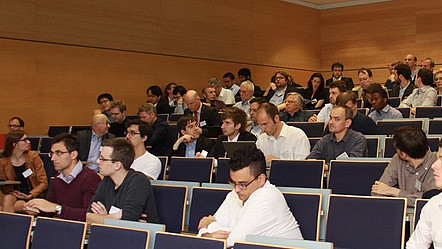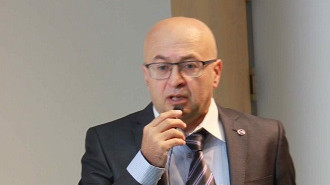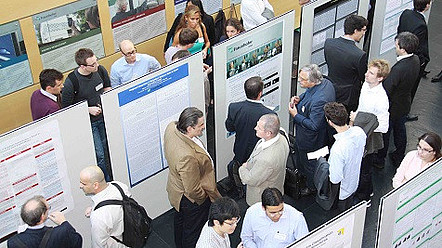Conference report on IEEE BIOSIG 2015
The 14th edition of the International Conference of the Biometrics Special Interest Group (BIOSIG) took place at Fraunhofer IGD in Darmstadt, Germany from September 9 to 11 and attracted 97 registered participants from 24 countries. This year participants even traveled all the way from Japan, South-Africa, Argentina and Brazil to Darmstadt in order to join the BIOSIG community.
The program was composed of scientific research contributions on the one hand and reports about large-scale applications on the other hand. The opening keynote talk was given by Fares Rahmun (Federal Office of Administration, BVA) and Maik Rudolf (Federal Police Germany, BPOL), who reported about the European Smart Borders initiative, which will have a mayor impact on the border crossing performance in the Schengen area. In October 2014 the European Commission had published a technical study that was identifying suitable options for the Smart Border implementation. The keynote talk reported about the proof of concept efforts and the pilot project led by the IT agency Eu-LISA. The German Border Police is involved in these efforts with a pilot project running at Frankfurt airport, where face-recognition, on-the-fly fingerprint-recognition and iris-recognition are tested for this purpose. The talk summarized early findings regarding throughput and accuracy of the tested technologies. The keynote was complemented with very recent information from Markus Nuppeney (German Federal Office for Information Security) on the management of masterlists and validation of CSCA certificates in the border control process of biometrics passports.
The second keynote was provided by Javier Ortega-Garcia (Universidad Autonoma De Madrid, Spain) about Cognitive Biometric Authentication. The talk discussed the need for remote authentication solutions (i. e., in web authentication or interacting with smartphones) that cannot be adequately met with the popular biometric technologies (i.e. fingerprint, face or iris). Cognitive biometrics emerged in this context towards a better authentication in web and mobile scenarios. User behavior, actions and responses are analyzed while interacting with certain devices or applications (such as common tasks with a smartphone), to carry out authentication along time. Behavioral biometric traits like speech, handwriting, or mouse dynamics in large volumes of data derived from human-machine interaction can improve continuous authentication systems making use of cognitive information.
Accepted conference contributions included 14 presentations covering fingerprint, vein, face, iris and gait recognition and also addressing segmentation challenges e.g. in iris recognition systems. Numerous contributions discussed this security of biometrics and specifically new biometric template protection schemes. Another relevant topic covered in the conference linking the biometrics and the forensics field with contributions on the performance of evidential value estimation for fingermarks. The poster session with 20 contributions was a good mix of research results from academic and industrial research labs and visitors did spend a long time in the poster exhibition before the start of the social event with the traditional late summer barbeque – providing lots of opportunities for networking.
On the last day of the conference Josef Bigun (Halmstad University, Sweden) addressed in his keynote the role of dense frequency and orientation maps in fingerprint processing. These maps can be used for low-quality image processing in general and image enhancement in fingerprints in particular. Such dense maps open up also a novel research question since a good estimation of both, allows continuous ridge counting. The interrelationship of both maps, and how to estimate them when none is known initially was explained in this presentation. It was explained, how both frequency and orientation maps of the same picture can successively improve each other, combined in an image enhancement scheme. In fingerprint recognition systems such an image enhancement scheme can be obtained simply by projections of local images on Gabor filters, dynamically calculated by using the dense frequency and orientation maps. Analytic and experimental comparisons with emphasis on understanding the relationship of the novel scheme to state of the art on forensic fingerprints, where the ground truth is known as test bed, were discussed. Various examples of typical fingerprint processing tasks such as ridge-counting, without ridge detection, thinning, etc. illustrated the methods.
The last conference day concluded with a comprehensive keynote by Ajay Kumar (Hong Kong Polytechnic University) presenting a complementary perspective on finger recognition challenge from knuckles to 3D finger recognition. He presented convincing arguments on the correlation of finger knuckle patterns with the anatomy of fingers that involve complex interaction of finger bones, tissues and skin. The potential from newly identified first and second minor finger knuckle patterns for biometrics applications was also presented with supporting matching performance results on database of over 500 subjects. Theoretical models to ascertain uniqueness of 3D fingerprints, over 2D fingerprints, and its interoperability with conventional 2D fingerprint database were also discussed. This talk detailed on recent advancements on hand-based biometrics, i.e. finger knuckle and 3D fingerprint identification, which can initiate new applications in law-enforcement, immigration, consumer and mobile biometrics.
As in previous BIOSIG conferences participants of the conference themselves voted for the best paper and the best poster that was presented at the conference. The winner of the BIOSIG 2015 best paper award is Andreas Ranftl (Halmstad University) for his presentation “Face Tracking Using Optical Flow: Development of a Real-Time AdaBoost Cascade Face Tracker“, which convinced the majority of the participants.
While the poster session showed many impressive research results that stimulated long discussions, there was one contribution, which was chosen by the participants as best and it received thus the BIOSIG 2015 best poster award. It was the poster of Lisa de Wilde (University of Twente, The Netherlands) with the title: “Exploring How User Routine Affects the Recognition Performance of a Lock Pattern“.
The BIOSIG conference was preceded by the 2nd EAB Research Project Conference and was further co-located with two satellite workshops:
The meeting of the TeleTrusT Biometric Working Group and joint meeting of the ethical committee of the European Association of Biometrics, and ethical and privacy working parties of the COST ACTION IC1106 and COST ACTION IC1206.
The 2015 BIOSIG conference was jointly organized by the Competence Center for Applied Security Technology (CAST) and the special interest group BIOSIG of the Gesellschaft für Informatik e.V. (GI).
The conference was technically co-sponsored by IEEE Biometric Council and the papers will be added to IEEE Xplore.
Next year the BIOSIG conference will take place between
September 21 to 23, 2016 in Darmstadt, Germany.





